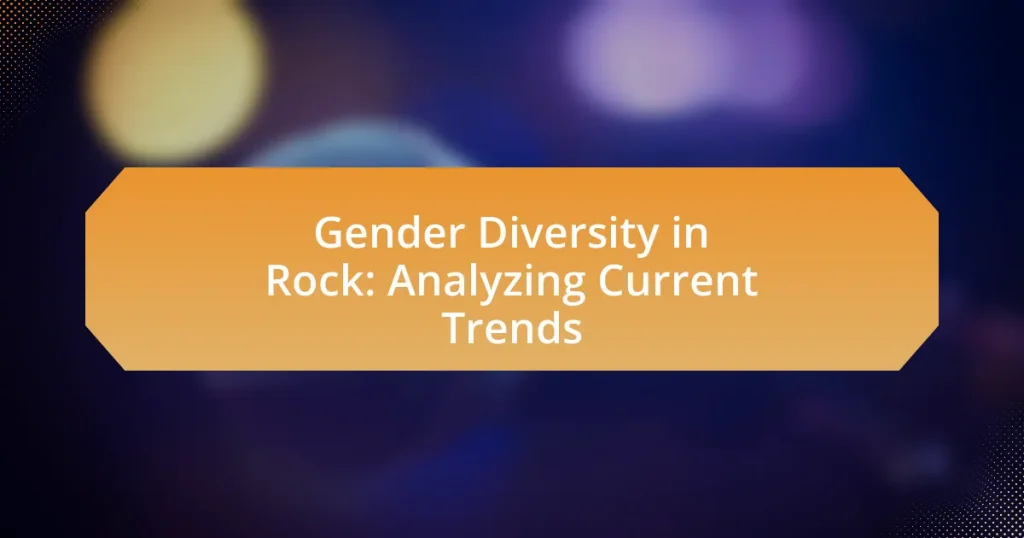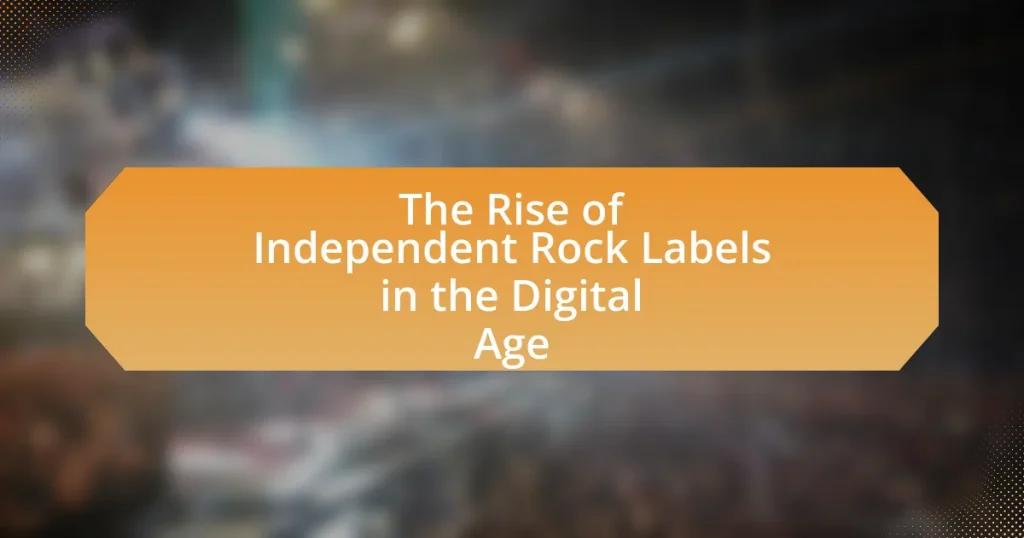Gender diversity in rock music refers to the representation and inclusion of individuals of various genders within the genre, highlighting the historical male dominance and the recent increase in female and non-binary artists. The article examines the importance of gender diversity for fostering creativity, innovation, and broader audience engagement, while also addressing the historical context shaped by feminist movements and the challenges faced by underrepresented artists. Current trends indicate a rise in female representation, with initiatives from festivals and organizations promoting inclusivity. The implications of gender diversity for the future of rock music include enhanced musical innovation and audience engagement, alongside practical steps for industry stakeholders and fans to support diverse artists.
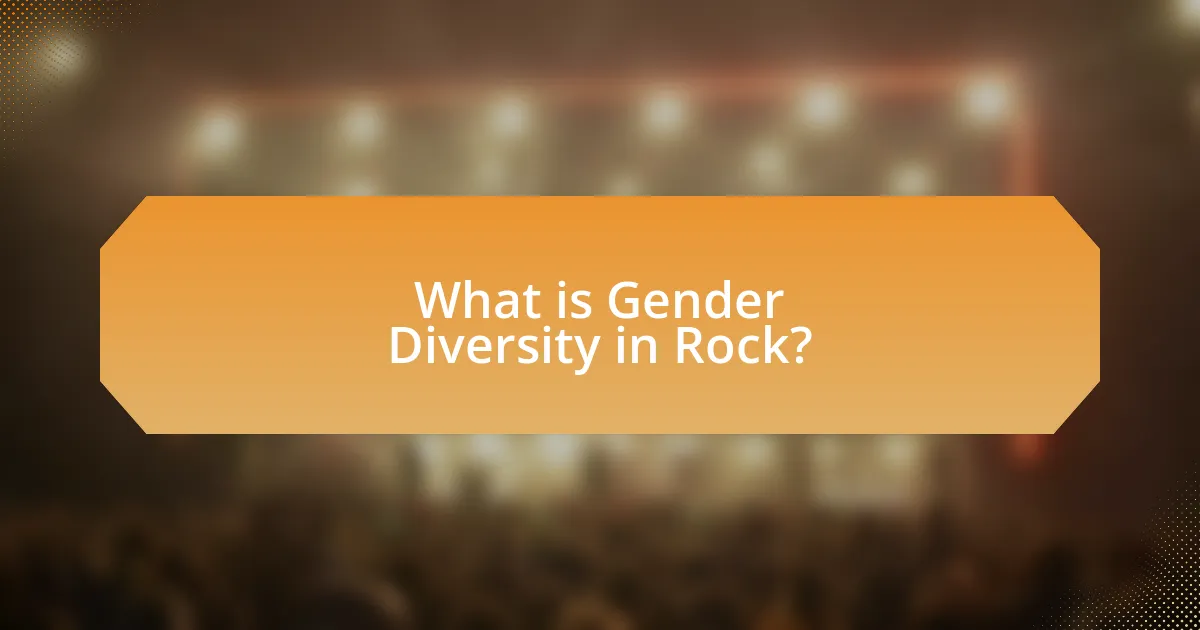
What is Gender Diversity in Rock?
Gender diversity in rock refers to the representation and inclusion of individuals of various genders within the rock music genre, encompassing artists, musicians, and industry professionals. Historically, rock music has been male-dominated, but recent trends show an increasing presence of women and non-binary individuals in both performance and production roles. For instance, a 2021 study by the Annenberg Inclusion Initiative found that women comprised only 21.7% of artists in popular music, highlighting the ongoing need for greater gender diversity. This shift is significant as it challenges traditional norms and promotes a more inclusive environment within the rock music scene.
Why is Gender Diversity important in the Rock genre?
Gender diversity is important in the Rock genre because it fosters creativity and innovation, leading to a richer musical landscape. Diverse perspectives contribute to varied lyrical themes and musical styles, enhancing the genre’s evolution. For instance, studies show that bands with gender diversity often produce more commercially successful music, as seen in the rise of female-fronted bands like Paramore and Halestorm, which have achieved significant chart success. Furthermore, gender diversity in Rock challenges stereotypes and promotes inclusivity, encouraging a broader audience engagement and participation in the genre.
What historical context has shaped Gender Diversity in Rock?
The historical context that has shaped gender diversity in rock includes the feminist movements of the 1960s and 1970s, which challenged traditional gender roles and promoted women’s rights in various fields, including music. This era saw the emergence of female rock artists like Janis Joplin and Joan Jett, who broke barriers and paved the way for future generations. Additionally, the 1990s grunge and riot grrrl movements further emphasized female empowerment and representation in rock, leading to increased visibility for women in the genre. These movements collectively contributed to a gradual shift in the rock music landscape, fostering a more inclusive environment for diverse gender identities.
How does Gender Diversity impact the music industry?
Gender diversity significantly impacts the music industry by fostering innovation and broadening audience appeal. Research indicates that diverse teams produce more creative outcomes; for instance, a study by the Berklee College of Music found that gender-diverse bands often attract larger and more varied fan bases. Additionally, the presence of women in leadership roles within music labels correlates with increased market performance, as companies with gender-diverse leadership see a 15% higher return on investment. This diversity not only enhances the artistic landscape but also drives economic growth within the industry.
What are the current trends in Gender Diversity within Rock music?
Current trends in gender diversity within rock music indicate a significant increase in female representation, both in bands and as solo artists. Data from the 2022 “Women in Music” report by the Annenberg Inclusion Initiative reveals that women comprised 23.3% of artists in the rock genre, a notable rise from previous years. Additionally, festivals are increasingly prioritizing gender-balanced lineups, with events like Glastonbury and Coachella committing to featuring more female acts. This shift reflects a broader cultural movement towards inclusivity and equality in the music industry, driven by advocacy groups and changing audience expectations.
Which artists are leading the way in promoting Gender Diversity?
Artists such as Hayley Williams, Brandi Carlile, and St. Vincent are leading the way in promoting gender diversity in the music industry. Hayley Williams, the frontwoman of Paramore, has been vocal about gender equality and has actively supported female artists through collaborations and mentorship. Brandi Carlile has received multiple awards for her advocacy for LGBTQ+ rights and gender equality, using her platform to highlight the importance of diversity in music. St. Vincent, known for her innovative sound and style, has also been an outspoken advocate for women in rock, often addressing gender issues in her work and public appearances. These artists exemplify a commitment to fostering an inclusive environment within the music scene.
How are music festivals addressing Gender Diversity in their lineups?
Music festivals are increasingly addressing gender diversity in their lineups by implementing policies that prioritize the inclusion of female and non-binary artists. For instance, major festivals like Coachella and Glastonbury have committed to achieving gender parity by actively seeking to book a balanced number of male and female performers. Research from the Annenberg Inclusion Initiative indicates that only 22.5% of artists on festival lineups were women in 2019, prompting many festivals to set specific diversity targets and initiatives to improve these statistics. Additionally, some festivals are creating mentorship programs and platforms specifically for underrepresented artists, further promoting gender diversity in the music industry.
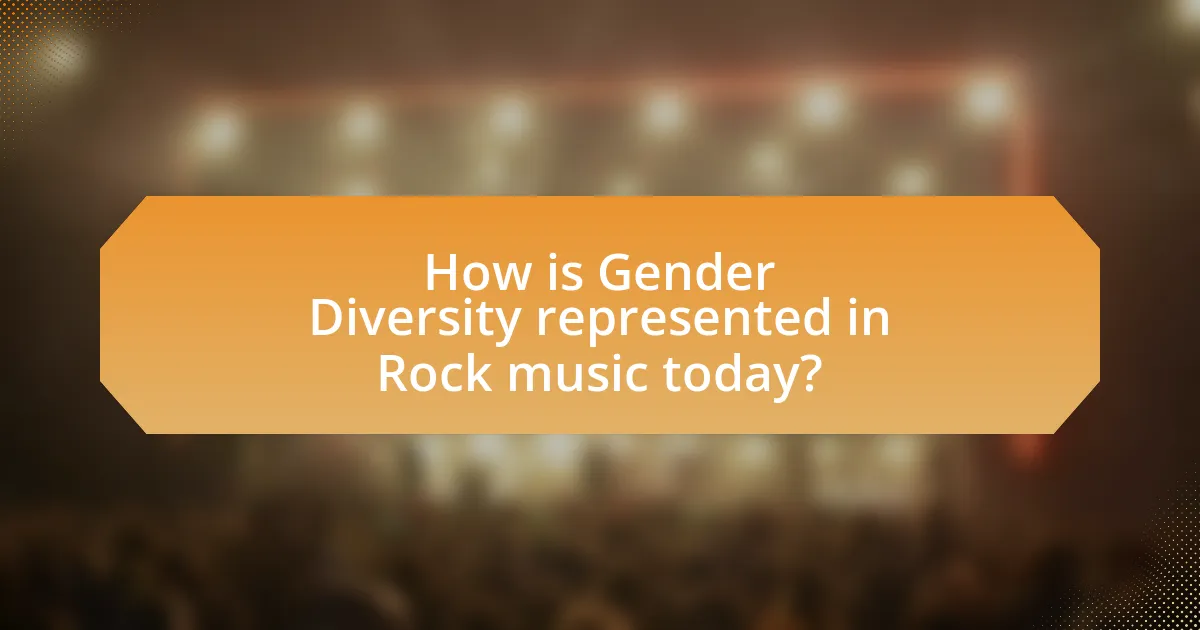
How is Gender Diversity represented in Rock music today?
Gender diversity in rock music today is represented through an increasing number of female artists and gender non-conforming musicians gaining visibility and recognition. For instance, artists like Halsey, Hayley Williams, and Brandi Carlile have achieved significant commercial success and critical acclaim, showcasing diverse perspectives and experiences within the genre. Additionally, organizations such as the Women’s International Music Network and initiatives like the “Girls Rock!” camps promote inclusivity and support for women and non-binary individuals in music. According to a 2021 report by the Annenberg Inclusion Initiative, women comprised 22.5% of artists in the rock genre, indicating a gradual but positive shift towards greater representation.
What challenges do female and non-binary artists face in Rock?
Female and non-binary artists in rock face significant challenges, including gender bias, lack of representation, and limited access to industry resources. Gender bias manifests in the form of stereotypes that question their musical abilities and authenticity, often leading to fewer opportunities for performances and promotions. According to a 2021 report by the Annenberg Inclusion Initiative, women comprised only 21.7% of artists in popular music, highlighting the lack of representation. Additionally, non-binary artists often encounter difficulties in being recognized and accepted within a predominantly binary framework, which can hinder their visibility and career advancement. These challenges are compounded by systemic issues in the music industry, such as unequal pay and fewer networking opportunities, making it harder for female and non-binary artists to thrive.
How do societal perceptions influence these challenges?
Societal perceptions significantly influence the challenges faced by gender diversity in rock music by shaping the expectations and opportunities available to artists. For instance, prevailing stereotypes about gender roles often lead to the underrepresentation of women in rock bands and festivals, as evidenced by statistics showing that only about 20% of artists at major music festivals are female. This perception creates barriers for women, discouraging them from pursuing careers in a genre traditionally dominated by men. Furthermore, societal attitudes can affect the reception of female artists, with studies indicating that women in rock often face harsher criticism and scrutiny compared to their male counterparts, impacting their visibility and success in the industry.
What barriers exist in the music industry for diverse gender representation?
Barriers in the music industry for diverse gender representation include systemic sexism, lack of access to resources, and industry gatekeeping. Systemic sexism manifests in unequal opportunities for women and non-binary individuals, often resulting in fewer female artists being signed to labels or receiving promotional support. Research by the Annenberg Inclusion Initiative found that only 22.4% of artists in popular music were women from 2012 to 2019, highlighting the disparity. Additionally, the lack of access to resources such as funding, mentorship, and networking opportunities further hinders diverse gender representation. Industry gatekeeping, where predominantly male decision-makers control which artists gain visibility, perpetuates these barriers, limiting the diversity of voices in the music landscape.
What initiatives are being taken to support Gender Diversity in Rock?
Initiatives to support gender diversity in rock music include mentorship programs, festivals dedicated to female artists, and industry partnerships aimed at increasing representation. Organizations like She Rocks Awards and Girls Rock Camp provide platforms for women in music, fostering talent and visibility. Additionally, festivals such as the Women’s Music Festival and initiatives by record labels to sign more female artists contribute to a more inclusive environment. These efforts are backed by statistics showing that female representation in music has been steadily increasing, with reports indicating a rise in female artists on festival lineups and in music charts.
How do mentorship programs contribute to Gender Diversity?
Mentorship programs significantly contribute to gender diversity by providing guidance, support, and networking opportunities specifically tailored for women in male-dominated fields like the music industry. These programs help to bridge the gender gap by fostering an environment where women can develop their skills, gain confidence, and access resources that may otherwise be unavailable to them. Research indicates that organizations with mentorship initiatives see a 30% increase in the representation of women in leadership roles, demonstrating the effectiveness of such programs in promoting gender diversity.
What role do record labels play in promoting diverse artists?
Record labels play a crucial role in promoting diverse artists by providing resources, marketing strategies, and industry connections that facilitate visibility and access to broader audiences. They often invest in promotional campaigns that highlight underrepresented voices, ensuring that diverse artists receive airplay, social media exposure, and opportunities for live performances. For instance, initiatives like the “Women in Music” program by the Recording Academy aim to support female artists and industry professionals, demonstrating a commitment to gender diversity. Additionally, statistics show that labels that prioritize diversity in their rosters tend to attract a wider audience, as consumers increasingly seek representation in the music they consume.
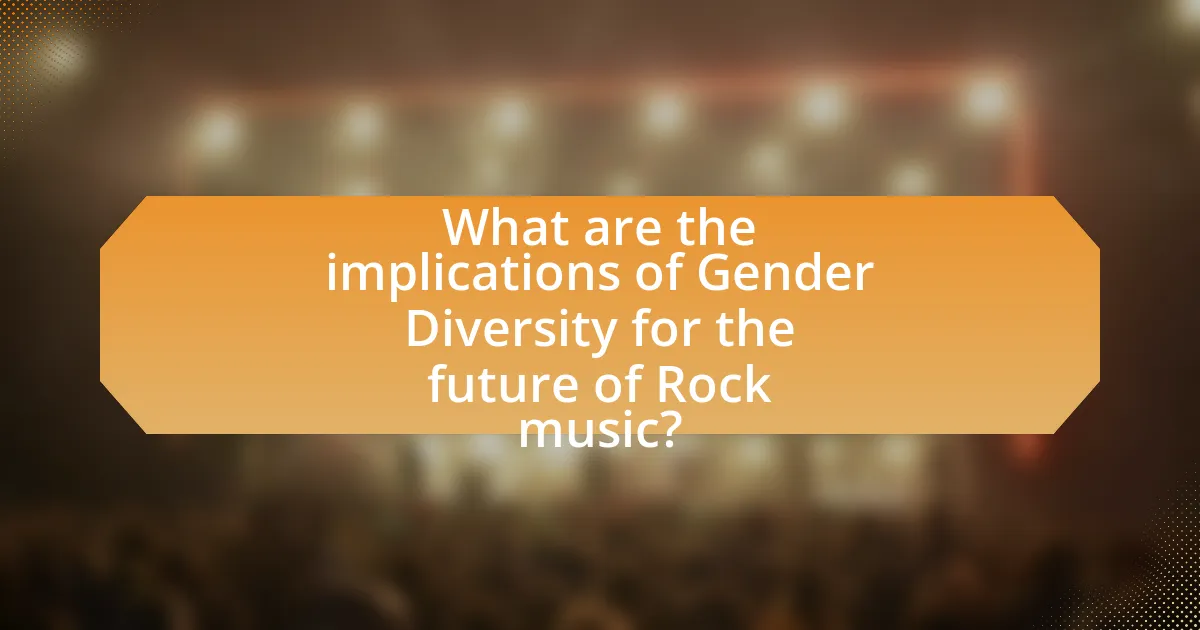
What are the implications of Gender Diversity for the future of Rock music?
Gender diversity will significantly shape the future of rock music by fostering innovation and expanding the genre’s appeal. As more female and non-binary artists enter the rock scene, they bring diverse perspectives and experiences that can lead to new sounds and themes, enriching the genre. For instance, the rise of artists like Haim and St. Vincent has already demonstrated how gender diversity can influence musical styles and lyrical content, attracting a broader audience. Furthermore, research from the Annenberg Inclusion Initiative highlights that gender-diverse representation in music correlates with increased commercial success, suggesting that embracing gender diversity can enhance the viability and relevance of rock music in contemporary culture.
How can increased Gender Diversity influence musical innovation?
Increased gender diversity can significantly influence musical innovation by introducing a wider range of perspectives, experiences, and creative approaches to music-making. Research indicates that diverse teams are more innovative; for instance, a study by McKinsey & Company found that companies with higher gender diversity are 21% more likely to outperform their peers in terms of profitability and value creation. In the context of music, this diversity can lead to the exploration of new genres, styles, and lyrical themes that resonate with broader audiences, ultimately pushing the boundaries of traditional rock music. Furthermore, the presence of women and non-binary artists in rock has historically led to the emergence of subgenres and movements, such as riot grrrl in the 1990s, which challenged societal norms and expanded the musical landscape.
What new sounds and styles emerge from diverse perspectives?
New sounds and styles in rock music emerge from diverse perspectives, particularly through the incorporation of varied cultural influences, gender identities, and personal experiences. For instance, artists like Janelle Monáe and Hayley Williams blend genres such as funk, pop, and punk, creating innovative sounds that challenge traditional rock norms. Additionally, the rise of non-binary and LGBTQ+ artists has introduced themes of identity and social justice into lyrics and performances, further diversifying the genre. Research indicates that gender diversity in music not only enriches artistic expression but also expands audience engagement, as seen in the increased popularity of female-fronted bands and collaborations across genres.
How does Gender Diversity affect audience engagement and fan culture?
Gender diversity positively affects audience engagement and fan culture by fostering inclusivity and broadening the appeal of music genres. Research indicates that diverse representation in rock music leads to increased participation from various demographic groups, enhancing the overall fan experience. For instance, a study by the Annenberg Inclusion Initiative found that gender-diverse lineups at music festivals correlate with higher attendance and engagement levels, as fans feel more represented and connected to the artists. This inclusivity not only attracts a wider audience but also cultivates a more vibrant and dynamic fan culture, where diverse voices and perspectives are celebrated.
What practical steps can be taken to enhance Gender Diversity in Rock?
To enhance gender diversity in rock music, industry stakeholders should implement targeted initiatives such as mentorship programs for female musicians, equitable hiring practices, and increased visibility of women in promotional materials. Research indicates that mentorship can significantly improve career outcomes; for instance, a study by the National Endowment for the Arts found that mentorship leads to higher retention rates for women in creative fields. Additionally, organizations like the Women’s Audio Mission advocate for gender equity in music production, demonstrating that inclusive hiring practices can lead to a more diverse talent pool. By prioritizing these steps, the rock music industry can create a more inclusive environment that supports and promotes female artists.
How can fans support diverse artists in the Rock genre?
Fans can support diverse artists in the Rock genre by actively promoting their music through social media platforms and attending their live performances. Engaging with diverse artists’ content online increases visibility and helps to build a larger audience. For instance, according to a 2021 report by the Annenberg Inclusion Initiative, only 22.5% of artists in the Rock genre were women, highlighting the need for increased support. By sharing their music, purchasing merchandise, and advocating for their inclusion in festivals and playlists, fans can contribute to a more equitable representation in the Rock music scene.
What best practices should venues adopt to promote inclusivity?
Venues should adopt best practices such as implementing accessible facilities, offering diverse programming, and fostering a welcoming environment to promote inclusivity. Accessible facilities include ramps, designated seating, and restrooms that accommodate individuals with disabilities, ensuring everyone can participate. Diverse programming involves featuring artists from various gender identities and backgrounds, which reflects the community’s diversity and attracts a broader audience. Additionally, fostering a welcoming environment can be achieved through staff training on inclusivity and creating policies that explicitly prohibit discrimination, thereby ensuring that all attendees feel safe and valued. These practices are supported by studies indicating that inclusive environments enhance participation and satisfaction among diverse groups.
